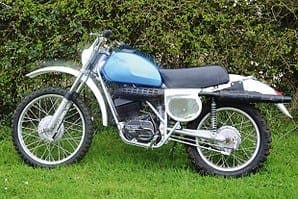
Back in 1976 Maurice Keen was serving in the Royal Navy based at Portsmouth. He had owned a string of Triumph twins, but was now looking for a bike that would provide the effortless long distance touring capability he needed, and his head was turned by the new 1000cc Honda Gold Wing. The deal was secured when he found a mint low mileage KO model, one of the first batch of Wings imported into the UK, at a local dealership. The bike was registered in November 1975 and had completed 9000 miles. The papers were duly signed, Maurice handed over his £980, and the one-year-old bike was delivered to Maurice care of HMS Mercury.
 Not long afterwards he met his future wife, and the trusty Wing became their favoured mode of transport. "We did all our courting on that bike," he told me, "but I never expected it to stay with us as a permanent threesome!" Twenty-nine years later the bike is still a part of the family, and has endured a total of 67,000 miles without suffering any serious mechanical problems. The only area he has found lacking on the bike is the quality of the standard exhaust system, which seems totally unable to cope with the climate in our remote corner of Northern Europe. "The bike is now on its fifth exhaust system, which seems designed to rot."
Not long afterwards he met his future wife, and the trusty Wing became their favoured mode of transport. "We did all our courting on that bike," he told me, "but I never expected it to stay with us as a permanent threesome!" Twenty-nine years later the bike is still a part of the family, and has endured a total of 67,000 miles without suffering any serious mechanical problems. The only area he has found lacking on the bike is the quality of the standard exhaust system, which seems totally unable to cope with the climate in our remote corner of Northern Europe. "The bike is now on its fifth exhaust system, which seems designed to rot."
Maurice was one of the first European visitors to Honda’s factory back in 1977, and remembers seeing CBXs on the production line. "They were making nine bikes a day," he remembers, "and I was struck by the attention to detail from the obviously dedicated workforce." His questions about the quality of the exhausts were met by uncomprehending stares from the Honda employees he spoke to. "The bikes were built and road tested in the kinder climate of Japan, and the people who designed and built them had never seen where they ended up being ridden." But, apart from the exhausts, Maurice has nothing but praise for the engineering on the Wing.
In 1979, career changes saw Maurice returning to live in his native Ireland, and the bike went with him. The bike lost its original P plate for an Eire registration, and was pressed into service as one of the few Gold Wings in Ireland. Over the next couple of decades the bike covered lots of miles in less than ideal conditions, and by the late 90s was beginning to look a little worse for wear. "My philosophy with this bike has always been; if it needs something, just buy it," he admits.
 The bike was duly despatched to the UK mainland for a full, no expense spared restoration. Work was progressing well when Maurice received a tip-off that the restorer was going bust, and bailiffs were advancing on the workshop to confiscate anything of value for the creditors. Not caring to argue the toss about the bike’s ownership, Maurice borrowed a Transit van and drove over to the UK mainland to snatch his precious Gold Wing from under the noses of the bailiffs. "I can't say any more about who or where it was, but I didn't want to end up going through the courts trying to prove ownership of my own bike."
The bike was duly despatched to the UK mainland for a full, no expense spared restoration. Work was progressing well when Maurice received a tip-off that the restorer was going bust, and bailiffs were advancing on the workshop to confiscate anything of value for the creditors. Not caring to argue the toss about the bike’s ownership, Maurice borrowed a Transit van and drove over to the UK mainland to snatch his precious Gold Wing from under the noses of the bailiffs. "I can't say any more about who or where it was, but I didn't want to end up going through the courts trying to prove ownership of my own bike."
The restoration was duly completed on home territory and the bike was put back into service. Maurice now reckons it’s beginning to look a little scruffy again, and is considering more refurbishment to once more bring it up to scratch.
The bike shares garage space with his Honda collection; a CBX1000Z and a brand-new Pan European, and a classic CL450 which, when we spoke, was on its way to ace restorer Paul Murphy for a thorough makeover. To prove he hasn't lost touch with his roots, Maurice also owns a 1954 Norton ES2, a British classic of the old school. And not a Triumph twin in sight…
Gold Wing, King of the tourers
The Gold Wing was originally conceived as ‘the King of Motorcycles’, and a prototype was first assembled in December 1972. Initial plans to use a 1470cc flat six engine producing 61bhp were shelved in favour of the flat four, only for it to re-emerge many years later as the GL1500. At its launch, the Gold Wing K1 was physically the largest mass production motorcycle in the shops, and seemed positively gargantuan compared to the Kettles and H2s that ruled the performance roost. Even the Kawasaki Z900 looked slim and svelte beside a Wing.
Honda’s design brief called for technology borrowed from their car range, and many engine internals were never originally designed with bike use in mind. Prototype Wings used a shaft drive set up bolted straight on from a /5 series BMW, a development of which made it to final production. Concerned about the ability of contemporary tyres to cope with the weight and power of the bike, Honda specified a 4.50 x 17 rear tyre, which was specially made for the bike as the size had never been used before. As a further concession to bulk the 4.2-gallon fuel tank was re-sited below the seat, the dummy tank consisting of a set of fold down panels concealing the electrics and air filter.
Despite its touring pretensions, US testers found the GL1000K1 beaten in acceleration only by the Kawasaki Z900, turning a best quarter-mile time of 12.92 seconds at 104.52mph.
 Despite the performance, some road testers of the time remained unimpressed. Bill Haylock of Bike magazine found the bike too similar to a two-wheeled car, and simply far too bulky to appeal to the traditional motorcyclist. He also criticised the range of the four-gallon tank, getting only 80 miles from the bike before the fuel gauge hit the red zone. Other testers were kinder, citing only minor niggles with switchgear to spoil the performance package.
Despite the performance, some road testers of the time remained unimpressed. Bill Haylock of Bike magazine found the bike too similar to a two-wheeled car, and simply far too bulky to appeal to the traditional motorcyclist. He also criticised the range of the four-gallon tank, getting only 80 miles from the bike before the fuel gauge hit the red zone. Other testers were kinder, citing only minor niggles with switchgear to spoil the performance package.
Motorcycle Mechanics’ John Robinson thraped a Wing around Cadwell Park, and amused himself watching the fork legs deflecting by "about half the diameter of the bottom leg" at 110mph. US testers loved the bike’s long distance, high speed ability, but the contemporary press had no inkling that the GL1000 was the forerunner of 1100, 1200 and 1500-6 variants which would create their own sub culture stretching into the next century. ![]()












